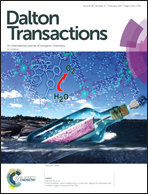Structural and magnetic properties of semiquinonate based Al(iii) and Ga(iii) complexes†
Abstract
The reaction of anhydrous MCl3 (M = Al(III) or Ga(III)) with one-electron-reduced 3,5-di-tert-butyl-1,2-ortho-benzoquinone (using metallic sodium) led us to isolate two distinct metal complexes of Al(III) and Ga(III), which were structurally and magnetically characterized. Complex 1 crystallized in the monoclinic P21/n space group, whereas 2 crystallized in the triclinic P![[1 with combining macron]](https://www.rsc.org/images/entities/char_0031_0304.gif) space group. Interestingly, whereas the Al(III) derivative was obtained as a dimer with the molecular formula [Al2(μ-HL−)2(L˙−)4] (1) (where L˙− is a semiquinonate radical and HL− is a monoanionic catecholate ligand), the Ga(III) derivative crystallized as [Ga(L˙−)3] (2), which is a polymorph of a previously reported complex. The presence of both catecholate and/or semiquinonate ligands in 1 and 2 was confirmed by single-crystal X-ray diffraction, mass spectrometry, and NMR and infrared spectroscopy techniques. The crystalline phase purity of the complexes was confirmed by powder X-ray diffraction (PXRD). Measurements of direct-current magnetic susceptibility, which were performed on a polycrystalline samples, revealed that in both complexes the semiquinonate radical anions are coupled ferromagnetically via the diamagnetic metal ion. The magnetism data of both complexes were modelled using the Heisenberg–Van Vleck–Dirac (HDVV) Hamiltonian, and the extracted parameters are consistent with the literature reports. The details of the electronic structures of the ground states of 1 and 2 were further investigated via X-band (ca. 9 GHz) electron paramagnetic resonance (EPR). The EPR spectrum of 2 could be reproduced by considering a quartet ground state with zero-field splitting and hyperfine coupling, whereas attempts to simulate all the EPR spectral features observed in a frozen solution of 1 by assuming it was a pure phase failed. A correct simulation required the simultaneous inclusion of contributions from a quartet and a triplet state. This evidently suggests that the dimeric complex of 1 is in equilibrium with a monomeric [Al(L˙−)3] complex in solution.
space group. Interestingly, whereas the Al(III) derivative was obtained as a dimer with the molecular formula [Al2(μ-HL−)2(L˙−)4] (1) (where L˙− is a semiquinonate radical and HL− is a monoanionic catecholate ligand), the Ga(III) derivative crystallized as [Ga(L˙−)3] (2), which is a polymorph of a previously reported complex. The presence of both catecholate and/or semiquinonate ligands in 1 and 2 was confirmed by single-crystal X-ray diffraction, mass spectrometry, and NMR and infrared spectroscopy techniques. The crystalline phase purity of the complexes was confirmed by powder X-ray diffraction (PXRD). Measurements of direct-current magnetic susceptibility, which were performed on a polycrystalline samples, revealed that in both complexes the semiquinonate radical anions are coupled ferromagnetically via the diamagnetic metal ion. The magnetism data of both complexes were modelled using the Heisenberg–Van Vleck–Dirac (HDVV) Hamiltonian, and the extracted parameters are consistent with the literature reports. The details of the electronic structures of the ground states of 1 and 2 were further investigated via X-band (ca. 9 GHz) electron paramagnetic resonance (EPR). The EPR spectrum of 2 could be reproduced by considering a quartet ground state with zero-field splitting and hyperfine coupling, whereas attempts to simulate all the EPR spectral features observed in a frozen solution of 1 by assuming it was a pure phase failed. A correct simulation required the simultaneous inclusion of contributions from a quartet and a triplet state. This evidently suggests that the dimeric complex of 1 is in equilibrium with a monomeric [Al(L˙−)3] complex in solution.



 Please wait while we load your content...
Please wait while we load your content...